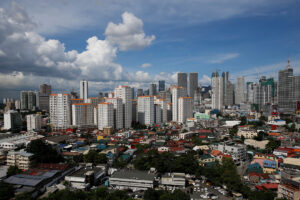THE PHILIPPINES needs to sustain 6% growth until next year to achieve upper middle-income status by 2026, according to National Economic and Development Authority (NEDA) Secretary Arsenio M. Balisacan.
“I think the upper middle-income status is challenging, but I think if we get 6% this year, 6% next year, we should achieve that upper middle-income status next year,” Mr. Balisacan told reporters during a briefing last week.
The Marcos administration is hoping to be reclassified as an upper middle-income economy this year or by 2026.
Growth of 6% matches the lower end of the government’s 6-8% growth target band for 2025-2028. It would exceed the 5.7% gross domestic product (GDP) posted in 2024, and the 5.5% in 2023.
The World Bank classifies countries by their gross national income (GNI). The four categories are low income, lower middle income, upper middle income and high income.
The Philippines is currently a lower middle-income country with GNI per capita of $4,230 in 2023, up from $3,950 in 2022.
Upper middle-income status is expected to require GNI per capita of between $4,516-$14,005.
Reinielle Matt M. Erece, economist at Oikonomia Advisory and Research, Inc. said upper middle-income status by next year is “still possible.”
“But it became more difficult as the economy takes a hit from heightened geopolitical risks especially in trade, remittances, and foreign investment,” he told BusinessWorld via Viber.
US President Donald J. Trump on April 9 paused his new reciprocal tariffs for 90 days, although the baseline 10% tariff on almost all US imports remains in effect.
The Philippines faced a 17% reciprocal tariff, the second lowest in Southeast Asia.
Mr. Erece said Philippine GDP must expand by 6-7% annually, though he expects growth to be at the lower end of the target.
Peter Lee U, dean of the University of Asia and the Pacific’s School of Economics, said should the tariffs cause a global recession, it could prevent the Philippines from moving up the income category.
Such a recession can “cause our GDP/gross national product to shrink and our GNI per capita to fall. It’s anybody’s guess whether that will happen. Also, if a global economic slowdown happens, it may take until 2026 before we feel the full effect,” he said via Viber.
JP Morgan estimates a 60% probability of the world economy going into recession by year’s end, up from 40% in March.
Jose Enrique A. Africa, executive director at think tank IBON Foundation said even if Mr. Trump backtracks on the tariffs, inflation is expected to slow growth this year and the next.
“The reputational damage to the US has been done and countries will start adjusting to a world of even more uncertain supply chains, fiscal austerity to accommodate security spending from the vacuum being left by the US, and more volatile finances from a shaken dollar,” he said via Viber.
“These make it unlikely for the Philippines to rise to upper middle income this year — the only question really being how long this reclassification is going to be delayed,” he added.
Before the tariff announcement, World Bank Country Director for the Philippines, Malaysia, and Brunei Zafer Mustafaoğlu said in February that the Philippines is likely to reach upper middle-income status by 2026.
However, Mr. Balisacan said instead of the fixation on income status, the more significant indicators are employment, poverty, literacy and hunger and living standards, rather than GDP or GNI.
Mr. Africa said the Marcos administration instead should prepare to cushion the economic disruption on the vulnerable members of society.
“It should expand public education, health, housing and social protection services, and give redoubled support to domestic food production to moderate prices. The backsliding on the sustainable development goals… risks getting even worse,” he said. — Aubrey Rose A. Inosante

